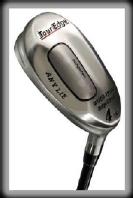PRODUCT REVIEW Product Review: Product Review:
Tour Edge Wood-Iron
By Kiel Christianson,
Senior Writer
First we had metal woods. Now we have wood-irons. If the blurring of categories and the bending of tradition send you into sputtering fits and rambling stories of how things were when you were young, read no further. If innovation intrigues you, however, we've tested out one of the newest non-classifiable clubs, the Any Lie Wood-Iron by Tour Edge, and what we found just might tempt you to take a walk on the hybrid side. The intuition behind hybrid clubs in general, and the Tour Edge Any Lie Wood-Iron in particular, is sound: Higher handicappers can't hit long irons consistently. At the same time, traditional fairway woods are hard to control, due to their long shafts, oblique lie angles, and larger clubheads, which tend to get hung up in the rough (where most higher-handicappers spend much of their time). Therefore, what most golfers need (since most golfers are higher-handicappers) is a club that offers the control and flexibility of an iron, with the launching power of a wood. Hence, the Wood-Iron. The Any Lie Wood-Iron promotes a more upright swing and descending blow, thanks to its somewhat shorter overall length and more upright lie angle. It's head is stainless steel, with a maraging steel clubface. We tested a. R-flex 19-degree version, made to take the place of your 2-iron, but the model comes in 13, 16, 19, 25, and 27 degree lofts to replace 5-wood through 5 iron. Responses from various golfers of varying skill-levels were, well, varied. A couple of guys couldn't get past the look of the club: The silvery head doesn't look like a wood, but the whole club sets up like an iron. These players just didn't know what to do with it, and usually tried to swing too easy, as they do with a fairway wood. The best strategy with the Wood-Iron, though, is to power through the ball, hitting down on it as you would with an iron. Players who did this found it to have an incredibly solid feel and serious length.
Personally, I hit it anywhere between 190 and 220 yards, depending on the lie. As such, it could have replaced either my 2-iron or 5-wood. The optimal conditions for the Wood-Iron for me were: (1) Long par 3s, where you need the ball to go far, go high, and land soft; and (2) Those irritating second shots on long par 4s, where you've hit a short slice/hook tee ball into the rough, and you have to both dig it out and send it 180+ yards to the green. One unique design feature of the Wood-Iron is the clubhead sole. Most fairway wood soles (and other hybrid clubs) have one or two contours or rails running parallel to the target line to promote an easy path through long grass. In contrast, the Wood-Iron has a multi-bounce sole, with two ridges running from toe to heel, and a super-heavy tungsten sole weight. The ridges supposedly reduce drag while keeping the club from digging in. And the weight definitely gets the ball airborne fast. Those whom we surveyed who used the club in the circumstances noted above - and who weren't too jarred by the club's nontraditional look - agreed that the Wood-Iron would be a valuable weapon in the fight against high scores. Those who didn't care for the club went back to "working" their long irons (the big show-offs). So, were you one of the first to dump your persimmon woods? If so, then you shouldn't have any trouble getting your mind around a hybrid club. And word on the street is, once you've had hybrid, you never go back. Club Specifications
Manufacturer: Tour Edge
Suggested retail price: $250
Clubhead: Stainless steel Clubface: Maraging steel
Lofts: 13, 16, 19, 25, and 27 degrees (to replace 5-wood through 5 iron)
Length: 40" - 42.5"
Shafts: steel, graphite (X, S, R, A, L)
Lefty: Yes
Info.: 800-515-3343
Web: www.touredge.com
|
 Product Review:
Product Review: